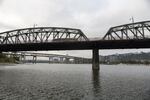
Oregon Health Authority recently issued a health warning after algae toxins were found in the Willamette river between Ross Island and Cathedral Park. Although the warning has been lifted in the downtown region, blue-green algae is still present in Ross Island Lagoon.
Miranda Daviduk / OPB
The Oregon State Marine Board is moving forward with new rules that restrict wake sports in a congested stretch of the Willamette River in Portland.
On Thursday, the board voted to advance a proposed rule that extends a no-wake zone in the Holgate Channel near Ross Island and establishes nearly 3 miles of "pass-through" zones between Waverly Marina and the Ross Island Bridge, where motorized boats will not be allowed to practice towed sports including water-skiing or wake surfing from May through September.
It's the latest move in an escalating dispute over how to manage conflicts between boats that create large wakes and other river users, who say those wakes create safety hazards for paddlers, damage property and cause environmental harm.
Renee Morgan with the Calm Water Coalition said her group was “shocked and very, very happy” when the marine board voted to move forward with new wake restrictions.
“It’s not really what we wanted,” Morgan said. “We wanted to say straight up, ‘Let’s not do any more wake sports in this highly congested part of the river, downtown Portland.' But we’re trying to make a compromise.”
Morgan said her coalition is worried about an increased number of safety problems caused by large wakes, including non-motorized boats being swamped with water, capsizing and even breaking apart.
The waves created by boats designed for wake sports can be 4-feet high, she said, putting paddlers, swimmers, homeowners and wildlife at risk. Her group is advocating for designated areas for wake sports near the Steel Bridge, where there is less risk of damage from their wakes.
“When the wake boats are in the area, everyone else changes their plans,” she said. “Because they are extremely disruptive and quite dangerous.”
Motorized boaters are pushing back against the new restrictions.
John McIsaac with the Willamette River Community Coalition said restricting where wake sports can take place could create new safety hazards by forcing more motorized recreation into smaller sections of the river.
“It just seems wrong during a time when families need to get out onto the river because of coronavirus,” he said. “It’s a bad time to be making restrictions on what people can do outdoors as a family. ... The river is for everyone.”
Boat owner Paige Stoyer told the marine board she thinks towed sports are being unfairly singled out for restrictions.
“The incidents of swampings we hear brought up by the [Clean Water Coalition] are about people not following rules,” Stoyer wrote in a letter to the board. “What we need is more education, enforcement of the existing rules especially during busy times, better signage in key areas, and more respect between user groups.”
The marine board will continue its rule-making process at its next meeting in October.
Meanwhile, the city of Portland is working on a South Reach River Plan that outlines a 20-year vision for a large swath of the river upstream from the Ross Island Bridge. Along with many other prescriptions for improving human access, wildlife habitat and safety in the river, the plan calls for 3 miles of no-wake zones between the Sellwood and Hawthorne bridges.
City Council may consider that plan in September, but boating restrictions will require action from the marine board.
Before Thursday's decision, the directors of three city bureaus asked the marine board to create much larger no-wake zones with limited boat speed instead of the pass-through zones that allow boats to travel at normal speeds.
They told the marine board they’re worried about boating safety and how it’s being managed in the crowded South Reach area.
“We are also very concerned about the negative impacts of wave energy producing boats and activities on light watercraft, threatened and endangered fish species and their habitat, riverbank erosion, and floating homes,” they wrote in a letter to the board. "We strongly encourage the [Oregon State Marine Board] to recognize the seriousness of public safety and natural resources’ concerns posed by the wave energy of certain boats in the Lower Willamette and institute a slow no‐wake zone from the Hawthorne Bridge to the Sellwood Bridge in the Lower Willamette area of Portland."
